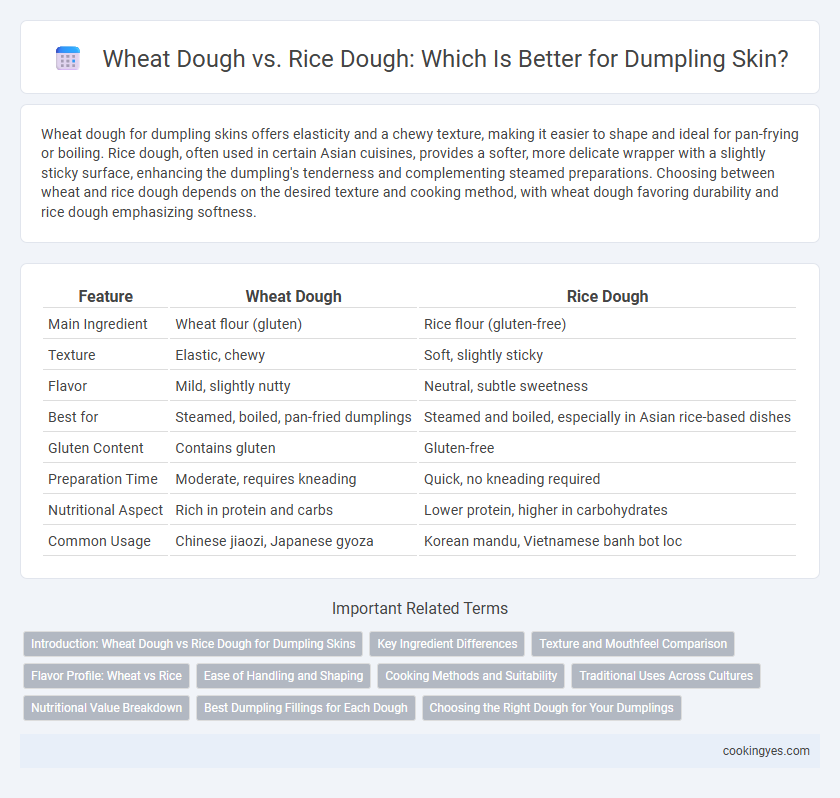Wheat dough for dumpling skins offers elasticity and a chewy texture, making it easier to shape and ideal for pan-frying or boiling. Rice dough, often used in certain Asian cuisines, provides a softer, more delicate wrapper with a slightly sticky surface, enhancing the dumpling's tenderness and complementing steamed preparations. Choosing between wheat and rice dough depends on the desired texture and cooking method, with wheat dough favoring durability and rice dough emphasizing softness.
Table of Comparison
| Feature | Wheat Dough | Rice Dough |
|---|---|---|
| Main Ingredient | Wheat flour (gluten) | Rice flour (gluten-free) |
| Texture | Elastic, chewy | Soft, slightly sticky |
| Flavor | Mild, slightly nutty | Neutral, subtle sweetness |
| Best for | Steamed, boiled, pan-fried dumplings | Steamed and boiled, especially in Asian rice-based dishes |
| Gluten Content | Contains gluten | Gluten-free |
| Preparation Time | Moderate, requires kneading | Quick, no kneading required |
| Nutritional Aspect | Rich in protein and carbs | Lower protein, higher in carbohydrates |
| Common Usage | Chinese jiaozi, Japanese gyoza | Korean mandu, Vietnamese banh bot loc |
Introduction: Wheat Dough vs Rice Dough for Dumpling Skins
Wheat dough for dumpling skins offers elasticity and a chewy texture due to gluten development, making it ideal for folding and steaming. Rice dough, often made from glutinous or non-glutinous rice flour, provides a softer, slightly sticky surface with a translucent appearance, popular in certain regional dumpling varieties such as Cantonese rice dumplings. Choosing between wheat and rice dough depends on texture preference and regional culinary tradition, affecting the dumpling's final mouthfeel and cooking method.
Key Ingredient Differences
Wheat dough for dumpling skins primarily contains gluten, providing elasticity and a chewy texture, while rice dough lacks gluten, resulting in a softer and more delicate skin ideal for steaming. The key ingredient in wheat dough is wheat flour, which enables dough stretching and folding without tearing, whereas rice dough relies on rice flour or a mixture of rice and tapioca flour, affecting moisture retention and_skin translucency. These ingredient differences significantly influence dumpling texture, cooking methods, and regional culinary preferences.
Texture and Mouthfeel Comparison
Wheat dough dumpling skins exhibit a chewy and elastic texture due to their gluten content, providing a satisfying bite and resilience during cooking. Rice dough skins have a tender, slightly sticky mouthfeel with a delicate softness that absorbs fillings' flavors well but lack the stretchiness of wheat dough. Texture contrast impacts dumpling experience, where wheat dough offers robustness and rice dough delivers a smoother, more tender skin.
Flavor Profile: Wheat vs Rice
Wheat dough for dumpling skins offers a chewy texture and a slightly nutty, wheaty flavor that complements savory fillings well. Rice dough provides a lighter, smoother texture with a subtly sweet taste, enhancing the delicate flavor of seafood or vegetable fillings. Choosing between wheat and rice dough significantly influences the overall taste and mouthfeel of the dumpling experience.
Ease of Handling and Shaping
Wheat dough offers greater elasticity and strength, making it easier to handle and shape into uniform dumpling skins without tearing. Rice dough tends to be more delicate and sticky, requiring gentle manipulation and often yielding thinner, more fragile wrappers. For efficient and consistent dumpling preparation, wheat dough is generally preferred by both home cooks and professional chefs.
Cooking Methods and Suitability
Wheat dough for dumpling skins offers elasticity and a chewy texture, making it ideal for boiling, steaming, and pan-frying methods where the dough must hold together under heat without tearing. Rice dough, made primarily from rice flour, has a softer, more delicate consistency suited for steaming, as it creates translucent, tender skins that are less robust and can break easily when boiled or fried. Choosing between wheat and rice dough depends on the desired texture and cooking technique, with wheat for versatile, durable dumplings and rice for light, soft steamed varieties.
Traditional Uses Across Cultures
Wheat dough is traditionally used in Northern Chinese and Eastern European dumplings due to its elasticity and ability to hold fillings securely, making it ideal for steaming or boiling methods. Rice dough, common in Southeast Asian dumplings like Vietnamese banh cuon or Filipino siomai, offers a translucent, chewy texture that pairs well with steaming and frying techniques. Cultural preferences for wheat or rice dough reflect regional grain availability and culinary traditions, influencing the texture and flavor profiles of dumplings worldwide.
Nutritional Value Breakdown
Wheat dough for dumpling skins contains higher protein and gluten, providing better elasticity and a chewier texture, while rice dough is lower in protein but gluten-free, making it suitable for individuals with gluten intolerance. Nutritionally, wheat dough offers more carbohydrates and fiber, beneficial for sustained energy and digestive health, whereas rice dough tends to be lighter with fewer calories and fat. Both dough types provide essential minerals like manganese and selenium, but wheat dough typically contains higher B vitamin content, crucial for metabolism and energy production.
Best Dumpling Fillings for Each Dough
Wheat dough dumpling skins offer a chewy texture ideal for hearty fillings like pork and cabbage, beef and onion, or robust vegetable blends that hold moisture well. Rice dough skins, being more delicate and slightly sticky, pair best with lighter, finely minced fillings such as shrimp, chicken with ginger, or mixed mushrooms to complement their subtle flavor. Choosing the dough depends on the filling's moisture and texture, ensuring optimal taste and dumpling integrity.
Choosing the Right Dough for Your Dumplings
Wheat dough offers a chewy texture and elasticity ideal for traditional boiled or pan-fried dumplings, maintaining shape without tearing. Rice dough provides a delicate, translucent skin favored in steamed dumplings, delivering a lighter, slightly sticky bite that complements Asian fillings. Selecting wheat or rice dough depends on cooking method and desired texture, influencing both flavor absorption and dumpling presentation.
Wheat Dough vs Rice Dough for Dumpling Skins Infographic

 cookingyes.com
cookingyes.com